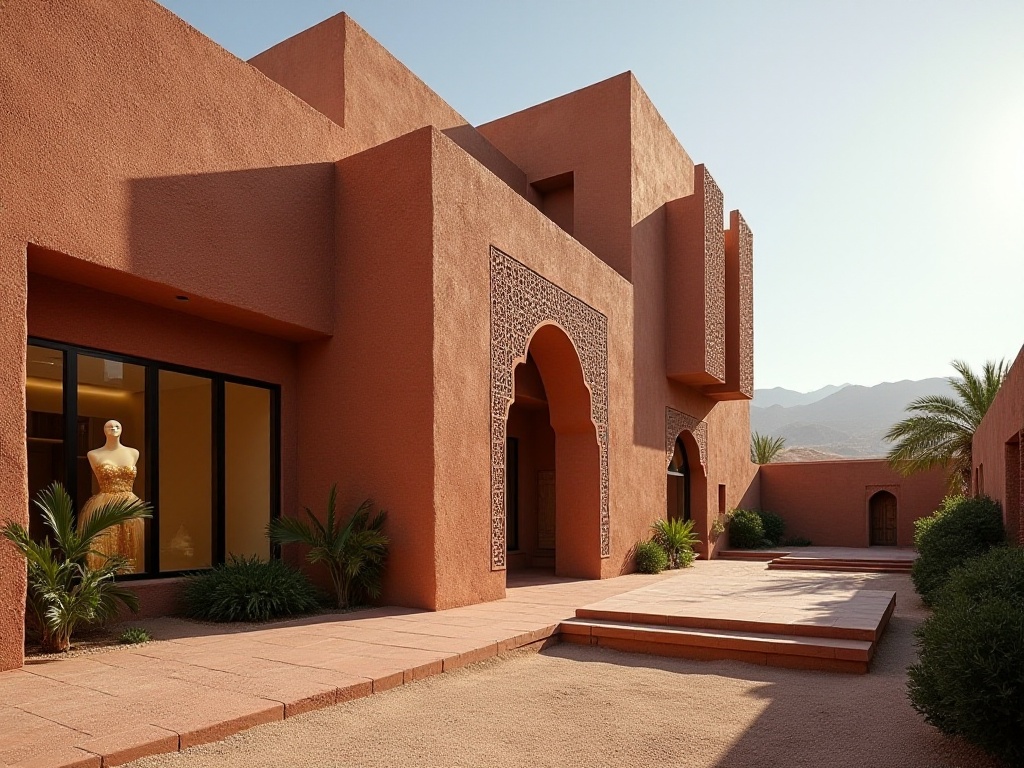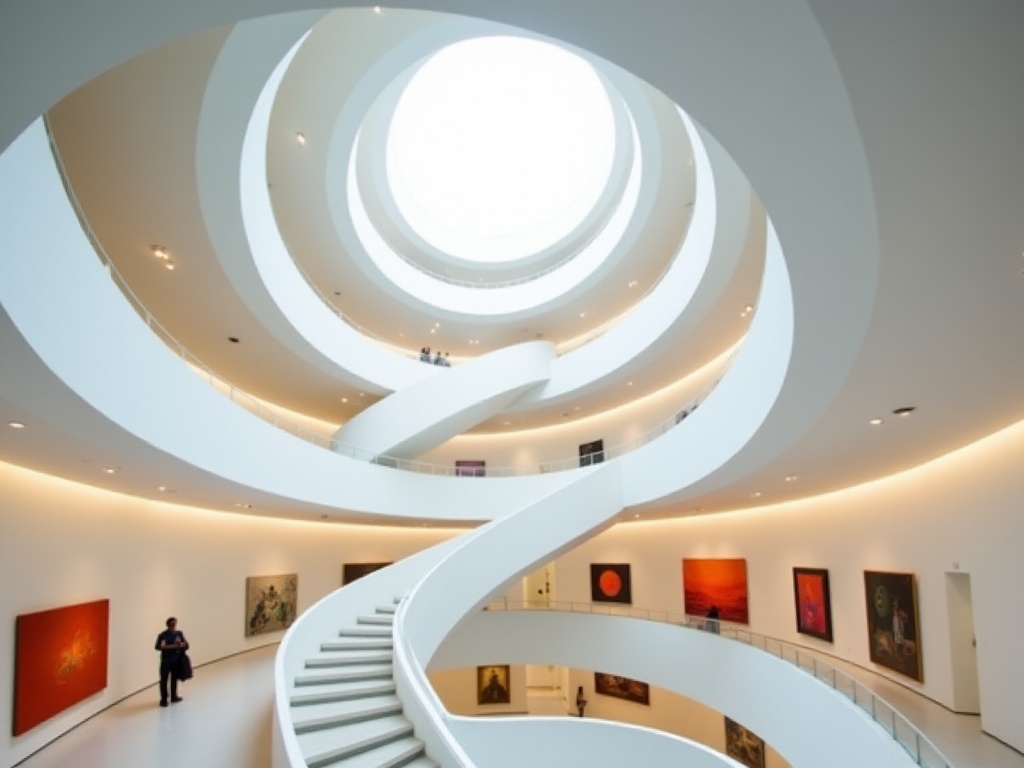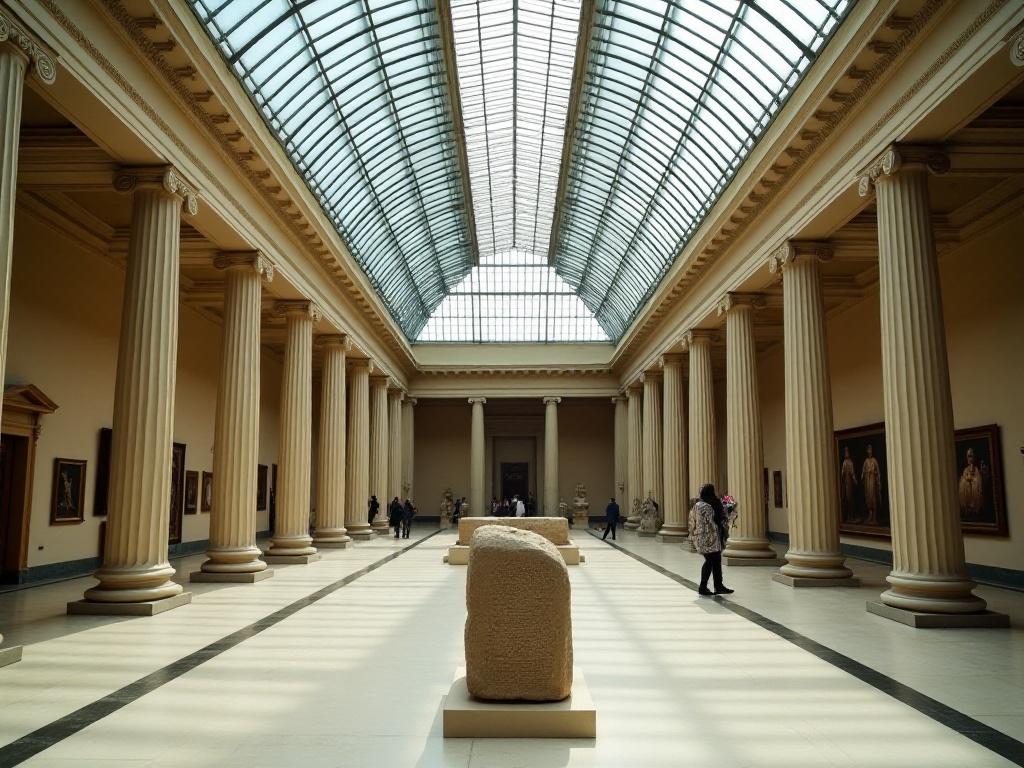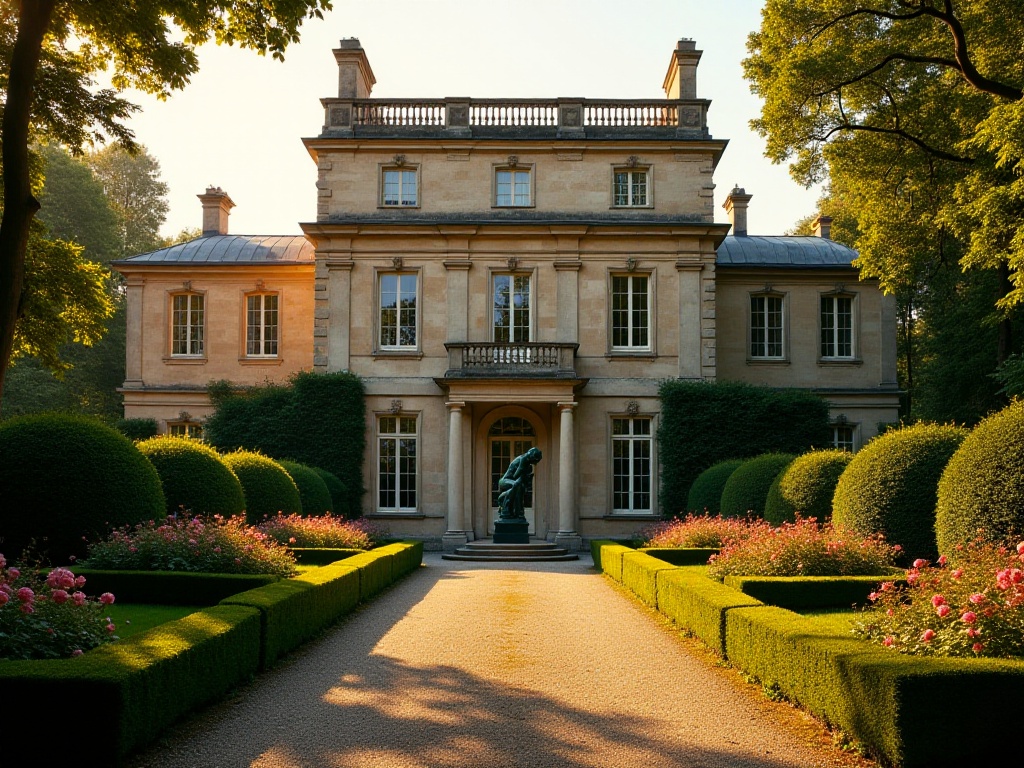Opening Thoughts
The scene of my first visit to the Guggenheim Museum in New York remains vivid in my memory. It was a sunny afternoon, with blue skies and white clouds framing this white building designed by master architect Wright, looking from afar like an elegant ribbon spiraling upward. The building itself is a work of art, with its white walls gleaming softly in the sunlight, as if extending a gentle invitation to every visitor.
Pushing through the heavy glass doors, I was greeted by the design-focused spiral gallery, like a white ribbon leading to an artistic paradise. Light poured in from the glass skylight above, casting shifting shadows on the white walls, filling the entire space with a sense of flowing rhythm. Each step felt like an exploration in the river of art, with every corner hiding a surprise.
Temple of Modern Art
The Guggenheim Museum is absolutely a shining jewel among modern art museums. The most enchanting aspect of this museum lies not only in its rich collection but also in its futuristic architectural design. The entire museum is like a giant inverted funnel, where visitors can slowly ascend along the spiral ramp, creating a unique visiting experience that leaves a deep impression.
Artworks from various periods hang on the walls along both sides of the ramp, from Impressionism to Post-Impressionism, from Surrealism to Abstract Expressionism, clearly showing the development of art history. Especially when standing at certain corners and looking back at the galleries below, the layered space becomes particularly prominent, as if viewing a three-dimensional artwork.
I remember encountering a special installation art exhibition there once, where the artist cleverly utilized the spiral structure to create a highly interactive work. Viewers could obtain completely different artistic experiences from different angles and heights. This perfect integration of architectural space and artwork made one marvel at the Guggenheim's unique charm.
In Asia, the National Museum of Modern Art in Seoul interprets modern art in another way. This museum, located in the heart of Korea's capital, though not as dramatically impressive as the Guggenheim from the outside, is equally impressive in its dedicated pursuit of contemporary art. The museum's architecture combines traditional Korean architectural elements with modern design language, creating a unique Eastern aesthetic atmosphere.
What's most surprising about the National Museum of Modern Art in Seoul is its strong support for local artists. The galleries showcase not only works by internationally renowned artists but even more creations by Korean local artists. These works often integrate traditional cultural elements with modern artistic expression, showing unique characteristics of Korean contemporary art.
The museum's outdoor space is also carefully designed, with large lawns complementing modern sculptures, providing an artistic oasis for urban dwellers. I particularly enjoy sitting in the museum's outdoor café on weekend afternoons, sipping coffee while appreciating artwork, experiencing the perfect fusion of art and life.

Traditional Art Treasures
Speaking of traditional art, the Musée d'Orsay in Paris is definitely one of my favorite places. This museum, converted from an abandoned train station, perfectly preserves the architectural style of the late 19th century industrial revolution. The soaring dome, exquisite sculptural decorations, and huge glass windows each tell stories of that steam age's glory.
Entering the Musée d'Orsay, the most striking feature is the giant clock window. Through this window, one can enjoy the charming views of the Seine River. Especially in the afternoon, when sunlight streams through the colored glass into the gallery, the entire space is bathed in a dreamlike play of light and shadow. Standing before Monet's Water Lilies series, with the scenery outside the window echoing the paintings, this unique viewing experience becomes unforgettable.
The museum's collections are arranged in chronological order and by artistic schools, from Realism to Impressionism, from Post-Impressionism to Symbolism, clearly showing the development of art history. Particularly the works of Impressionist masters like Monet, Van Gogh, and Cézanne - their most representative works can all be found here.
In the fifth-floor restaurant, one can not only enjoy delicious French cuisine but also appreciate Paris's most beautiful urban landscapes. I remember spending an unforgettable afternoon tea time here once. Looking at Paris's rooftop scenery through the restaurant's glass dome, sipping aromatic coffee, feeling the strong artistic atmosphere - that experience was simply wonderful.
As for the Rodin Museum, its story is even more romantic. This museum located in Paris's urban area was originally Rodin's late-life residence. When it opened in 1919, the entire garden was filled with Rodin's sculptures, forming a unique art garden.
The most charming aspect of the Rodin Museum is how it perfectly integrates art with nature. The garden is planted with various flowers, especially roses, and when they bloom in spring, the entire area becomes a colorful painting. Famous sculptures like "The Thinker" and "The Gates of Hell" appear particularly vivid in this verdant environment.
I most enjoy visiting the Rodin Museum at dusk. When the sunset's rays fall on the bronze sculptures, the metallic texture interplays with the warm light, creating unique visual effects. Especially "The Kiss" - this work appears particularly moving in the twilight, as if one can feel the strong emotions contained within the sculpture.
The museum's indoor galleries are equally impressive. They display not only Rodin's sculptures but also his drawings and photographs. Through these works in different media, we can more comprehensively understand this sculpture master's artistic journey. Each piece seems to tell a moving story, making visitors pause and reflect.

The Scroll of Human Civilization
The British Museum is like a weighty book of human civilization history, with each gallery being an fascinating chapter. This oldest public museum in the world has collected precious artifacts from around the globe, and although controversies about artifact ownership have never ceased, it indeed provides us with an excellent window to understand human civilization's development.
Entering the British Museum's hall, the first thing that catches the eye is that iconic glass dome. Sunlight streaming through the glass onto the white marble floor creates unique light effects. This modern architectural element designed by Norman Foster forms an interesting contrast with the museum's classical exterior.
The Egyptian Gallery can be said to be one of the British Museum's most popular exhibition areas. Here, there's not only the famous Rosetta Stone but also an astonishing number of mummies and burial goods. Standing before these exhibits feels like traveling back to ancient Egyptian civilization thousands of years ago. Especially those exquisite murals and reliefs showcase ancient Egyptians' extraordinary artistic talent and pursuit of eternal life.
The Greek and Roman section allows people to appreciate the glory of classical civilization. The Parthenon sculptures, ancient Greek pottery, Roman-era statues - each exhibit tells stories of that golden age. Although there have always been controversies about the ownership of the Elgin Marbles, it must be said that these exhibits indeed give us the opportunity to experience ancient Greek art's charm up close.
The Asian collection's artifacts are equally impressive. From Chinese bronzes to Japanese ukiyo-e prints, from Indian Buddhist art to Islamic calligraphy, they showcase the diversity and unique charm of Eastern civilization. Especially those murals from Dunhuang make one marvel at the cultural exchanges along the ancient Silk Road.
Now, the British Museum has also launched virtual tour services, allowing audiences worldwide to appreciate these precious artifacts online. Through high-definition images and detailed explanations, people can deeply understand the stories behind these artifacts even without leaving home. This digital display method not only makes art dissemination more convenient but also provides new ideas for artifact preservation.

Specialty Theme Museums
In Marrakech, Morocco, the Yves Saint Laurent Museum interprets the relationship between fashion and art in a unique way. This museum, situated next to the Majorelle Garden, surrounded by lush plants and bright colors, perfectly embodies the designer's deep affection for Morocco.
The museum building itself is a work of art, with modern minimalist design style perfectly integrated with traditional Moroccan architectural elements. Entering the gallery, the first thing that catches the eye is Saint Laurent's classic works from different periods. From his early designs while working at Dior to later works influenced by Moroccan culture, we can clearly see the evolution of his design philosophy.
Particularly impressive are those clothing designs that integrate Eastern and Western elements. Vibrant colors, bold patterns, exquisite embroidery all demonstrate the designer's love for traditional Moroccan craftsmanship. The museum displays not only ready-to-wear pieces but also houses a large collection of design sketches, fabric samples, and accessories, allowing visitors to deeply understand the complete process of clothing design.
In another area of the museum, Saint Laurent's personal items and photographs from his life in Morocco are displayed. Through these details, we can feel the deep emotional connection between this design master and Morocco. Especially his private residence in the Majorelle Garden, now open to the public as part of the museum, allows people to experience the designer's lifestyle up close.
Speaking of special museums, London's Museum of Travel Items is definitely a delightful discovery. This small but exquisite museum doesn't display precious artworks, but instead tells stories of life from around the world through ordinary people's travel items.
The museum's collection is diverse, from old suitcases to vintage postcards, from old maps to travel diaries, each item carries unique memories. Particularly interesting are those passports and tickets from different eras - through these simple pieces of paper, we can glimpse travel methods and life conditions from different periods.
My favorite is a special exhibition area in the museum dedicated to souvenirs from around the world. These seemingly ordinary items record each traveler's story. Some are exotic handicrafts, while others are just ordinary tickets or napkins, but behind each item is a moving story.
The museum regularly holds themed exhibitions, inviting people to share their travel stories and items. This interactive exhibition method makes the museum more vivid and interesting. Sometimes, an ordinary train ticket or a faded photograph can often evoke people's most genuine emotional resonance.

Concluding Thoughts
Through this global museum tour, I deeply feel that museums are not just collections of artifacts, but mirrors reflecting human civilization. Each museum tells stories in its own unique way, and these stories continuously inspire us to think about the relationship between life and art.
From the Guggenheim's modern art to the British Museum's scroll of civilization, from the Musée d'Orsay's Impressionist masterpieces to the Museum of Travel Items' life memories, each place has given me new insights. These museums are like pearls scattered around the world, stringing together the brilliant necklace of human civilization.
Walking through these museums, we can not only appreciate humanity's artistic achievements but also feel the collision and fusion between different cultures. Each museum is a window allowing us to glimpse the human aspects of different eras and regions. This experience is far more meaningful than mere sightseeing - it makes our hearts richer and our horizons broader.


